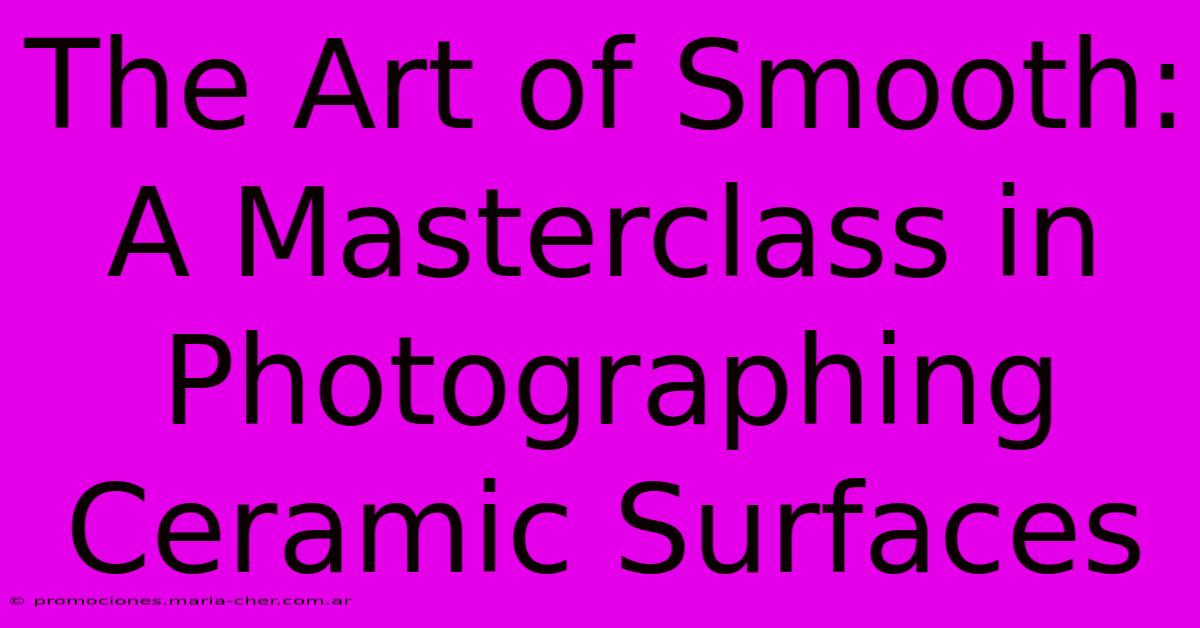The Art Of Smooth: A Masterclass In Photographing Ceramic Surfaces

Table of Contents
The Art of Smooth: A Masterclass in Photographing Ceramic Surfaces
Ceramic surfaces – from the glossy gleam of a modern teacup to the rustic matte of a hand-thrown bowl – present unique challenges and rewards for photographers. Capturing their texture, color, and subtle nuances requires a keen eye and a mastery of lighting and technique. This masterclass will delve into the art of photographing ceramic surfaces, helping you achieve stunning, professional-quality images.
Understanding Your Subject: The Nature of Ceramic
Before we dive into techniques, let's understand what makes ceramic photography unique. Ceramic surfaces can be incredibly reflective, resulting in unwanted glare and distracting highlights. They also exhibit a wide range of textures, from highly polished and smooth to rough and porous. Understanding these characteristics is crucial to selecting the right approach.
Identifying Key Features:
- Surface Finish: Is it glossy, matte, satin, or textured? This dictates your lighting choices significantly.
- Color and Tone: Are the colors vibrant or muted? Do you want to emphasize specific hues?
- Form and Shape: The shape of the ceramic object will influence how light interacts with the surface.
- Details and Imperfections: Are there unique markings, crazing, or other details you want to highlight?
Mastering the Lighting: The Key to Success
Lighting is arguably the most critical aspect of ceramic photography. The goal is to illuminate the surface evenly, revealing its texture and color without creating harsh shadows or distracting reflections.
Lighting Techniques for Smooth Surfaces:
- Soft, Diffused Light: This is your best friend for glossy ceramics. Avoid direct sunlight or harsh flash; instead, use softboxes, umbrellas, or diffusers to create a gentle, even light. This minimizes reflections and brings out the subtle nuances of the surface.
- Backlighting: Backlighting can create a beautiful glow and highlight the translucency of certain ceramics. Be careful to avoid overexposure and use fill light to prevent the object from becoming a silhouette.
- Side Lighting: Side lighting is excellent for emphasizing texture and form. It creates subtle shadows that reveal the contours of the piece. Experiment with the angle of your light source to achieve the desired effect.
Avoiding Unwanted Reflections:
- Polarizing Filters: A polarizing filter can significantly reduce glare and reflections, especially on glossy surfaces. Experiment with its rotation to find the optimal angle.
- Light Placement: Careful positioning of your light sources can minimize reflections. Try different angles and distances to find the sweet spot.
- Black or Dark Backgrounds: Using a dark or black backdrop helps absorb light and reduce distracting reflections.
Composition and Styling: Elevating Your Photography
While lighting is essential, composition and styling are equally important in creating a captivating image.
Compositional Considerations:
- Rule of Thirds: Utilize the rule of thirds to create a visually balanced and engaging composition.
- Leading Lines: Use lines within the scene to guide the viewer's eye to the ceramic object.
- Negative Space: Don't be afraid to incorporate negative space to make your subject stand out.
Styling Your Shot:
- Contextual Elements: Consider adding props that complement the ceramic piece and tell a story. This could be a teabag, a spoon, or a piece of fabric.
- Color Coordination: Pay attention to color harmony. Choose props and backgrounds that complement the colors of the ceramic.
- Minimalism: Sometimes, less is more. A clean, minimalist approach can highlight the beauty of the ceramic itself.
Post-Processing: The Finishing Touches
Post-processing can further enhance your ceramic photographs. However, remember to keep it subtle and natural.
Essential Post-Processing Steps:
- White Balance: Ensure accurate color representation.
- Exposure Adjustment: Fine-tune brightness and contrast.
- Minor Spot Removal: Eliminate any dust or blemishes.
- Sharpness: Enhance the sharpness of the image without overdoing it.
Conclusion: Practice Makes Perfect
Mastering the art of photographing ceramic surfaces takes time and practice. Experiment with different lighting techniques, compositions, and styling approaches to find what works best for you. Pay attention to the details and don't be afraid to experiment. The rewards – stunning images that showcase the beauty and craftsmanship of ceramic objects – are well worth the effort. So grab your camera, find your inspiration, and start capturing the smooth artistry of ceramics.

Thank you for visiting our website wich cover about The Art Of Smooth: A Masterclass In Photographing Ceramic Surfaces. We hope the information provided has been useful to you. Feel free to contact us if you have any questions or need further assistance. See you next time and dont miss to bookmark.
Featured Posts
-
Unlock The Hidden Charm Of Second Hole Piercings The Secret To Enchanting Ears
Feb 07, 2025
-
Peek Into The Past With Visconti Sforza A Historical Journey Through Tarot
Feb 07, 2025
-
Vermeil Vs Gold Plated The Battle Of The Budget Friendly Luxuries
Feb 07, 2025
-
Baguette Spectrum A Kaleidoscope Of Crusty Delights
Feb 07, 2025
-
Raw And Unfiltered Unleash The Intensity Of Gritty Textures
Feb 07, 2025
